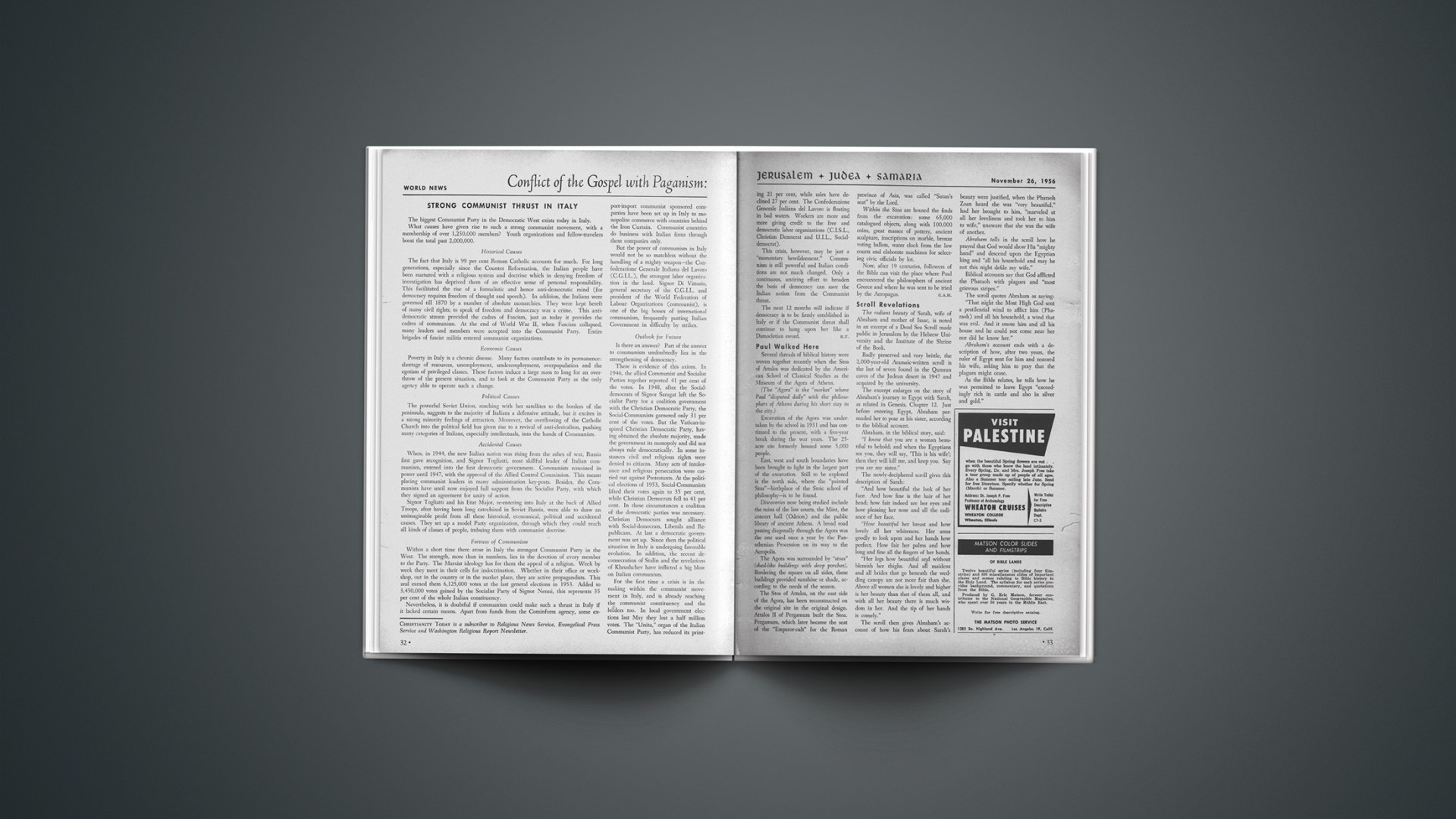Paul Walked Here
Several threads of biblical history were woven together recently when the Stoa of Attalos was dedicated by the American School of Classical Studies as the Museum of the Agora of Athens.
(The “Agora” is the “market” where Paul “disputed daily” with the philosophers of Athens during his short stay in the city.)
Excavation of the Agora was undertaken by the school in 1931 and has continued to the present, with a five-year break during the war years. The 25-acre site formerly housed some 5,000 people.
East, west and south boundaries have been brought to light in the largest part of the excavation. Still to be explored is the north side, where the “painted Stoa”—birthplace of the Stoic school of philosophy—is to be found.
Discoveries now being studied include the ruins of the law courts, the Mint, the concert hall (Odeion) and the public library of ancient Athens. A broad road passing diagonally through the Agora was the one used once a year by the Panathenian Procession on its way to the Acropolis.
The Agora was surrounded by “stoas” (shed-like buildings with deep porches). Bordering the square on all sides, these buildings provided sunshine or shade, according to the needs of the season.
The Stoa of Attalos, on the east side of the Agora, has been reconstructed on the original site in the original design. Attalos II of Pergamum built the Stoa. Pergamum, which later became the seat of the “Emperor-cult” for the Roman province of Asia, was called “Satan’s seat” by the Lord.
Within the Stoa are housed the finds from the excavation: some 65,000 catalogued objects, along with 100,000 coins, great masses of pottery, ancient sculpture, inscriptions on marble, bronze voting ballots, water clock from the law courts and elaborate machines for selecting civic officials by lot.
Now, after 19 centuries, followers of the Bible can visit the place where Paul encountered the philosophers of ancient Greece and where he was sent to be tried by the Aeropagus.
G.A.H.
Scroll Revelations
The radiant beauty of Sarah, wife of Abraham and mother of Isaac, is noted in an excerpt of a Dead Sea Scroll made public in Jerusalem by the Hebrew University and the Institute of the Shrine of the Book.
Badly preserved and very brittle, the 2,000-year-old Aramaic-written scroll is the last of seven found in the Qumran caves of the Judean desert in 1947 and acquired by the university.
The excerpt enlarges on the story of Abraham’s journey to Egypt with Sarah, as related in Genesis, Chapter 12. Just before entering Egypt, Abraham persuaded her to pose as his sister, according to the biblical account.
Abraham, in the biblical story, said:
“I know that you are a woman beautiful to behold; and when the Egyptians see you, they will say, ‘This is his wife’; then they will kill me, and keep you. Say you are my sister.”
The newly-deciphered scroll gives this description of Sarah:
“And how beautiful the look of her face. And how fine is the hair of her head; how fair indeed are her eyes and how pleasing her nose and all the radiance of her face.
“How beautiful her breast and how lovely all her whiteness. Her arms goodly to look upon and her hands how perfect. How fair her palms and how long and fine all the fingers of her hands.
“Her legs how beautiful and without blemish her thighs. And all maidens and all brides that go beneath the wedding canopy are not more fair than she. Above all women she is lovely and higher is her beauty than that of them all, and with all her beauty there is much wisdom in her. And the tip of her hands is comely.”
The scroll then gives Abraham’s account of how his fears about Sarah’s beauty were justified, when the Pharaoh Zoan heard she was “very beautiful,” had her brought to him, “marveled at all her loveliness and took her to him to wife,” unaware that she was the wife of another.
Abraham tells in the scroll how he prayed that God would show His “mighty hand” and descend upon the Egyptian king and “all his household and may he not this night defile my wife.”
Biblical accounts say that God afflicted the Pharaoh with plagues and “most grievous stripes.”
The scroll quotes Abraham as saying: “That night the Most High God sent a pestilential wind to afflict him (Pharaoh) and all his household, a wind that was evil. And it smote him and all his house and he could not come near her nor did he know her.”
Abraham’s account ends with a description of how, after two years, the ruler of Egypt sent for him and restored his wife, asking him to pray that the plagues might cease.
As the Bible relates, he tells how he was permitted to leave Egypt “exceedingly rich in cattle and also in silver and gold.”










